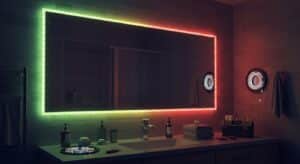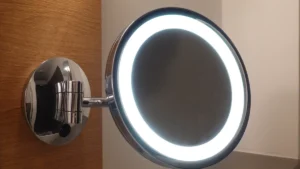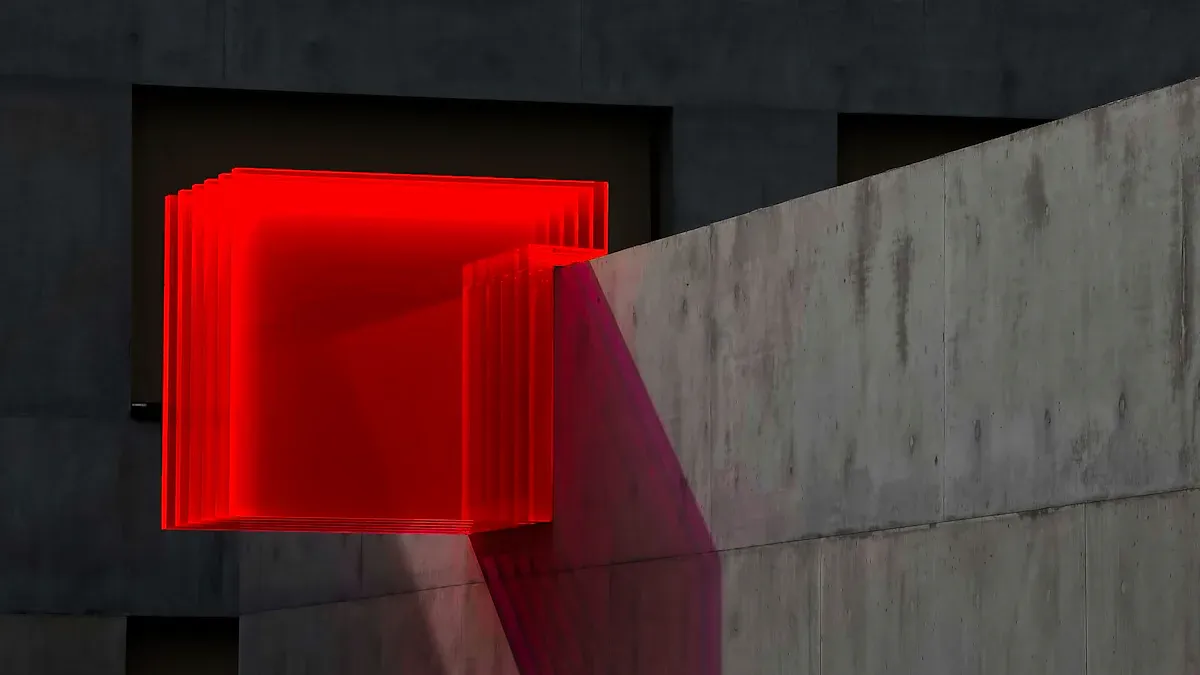
Creating an LED light box might seem hard, but it’s simple! You don’t need special skills or expensive tools to begin. With some cheap materials, you can make a lightbox that looks great and works well.
Why spend money on costly store-bought ones when you can DIY? Making it yourself saves money, lets you pick your style, and feels rewarding. Whether for fun or to improve your space, anyone can do this project, no matter their experience.
Key Takeaways
Collect basic items like wood, metal strips, plastic sheets, and LED lights to make your light box frame.
Add personal touches like colorful LED lights, dimmers, or fancy edges to fit your taste.
Measure, cut, and put together the frame step by step for a strong and neat design.
Spread light evenly by changing LED brightness and using covers to make your art look better.
Pick a good spot for your light box where it stands out, thinking about brightness and how easy it is to see.
Materials and Tools for Your LED Light Box
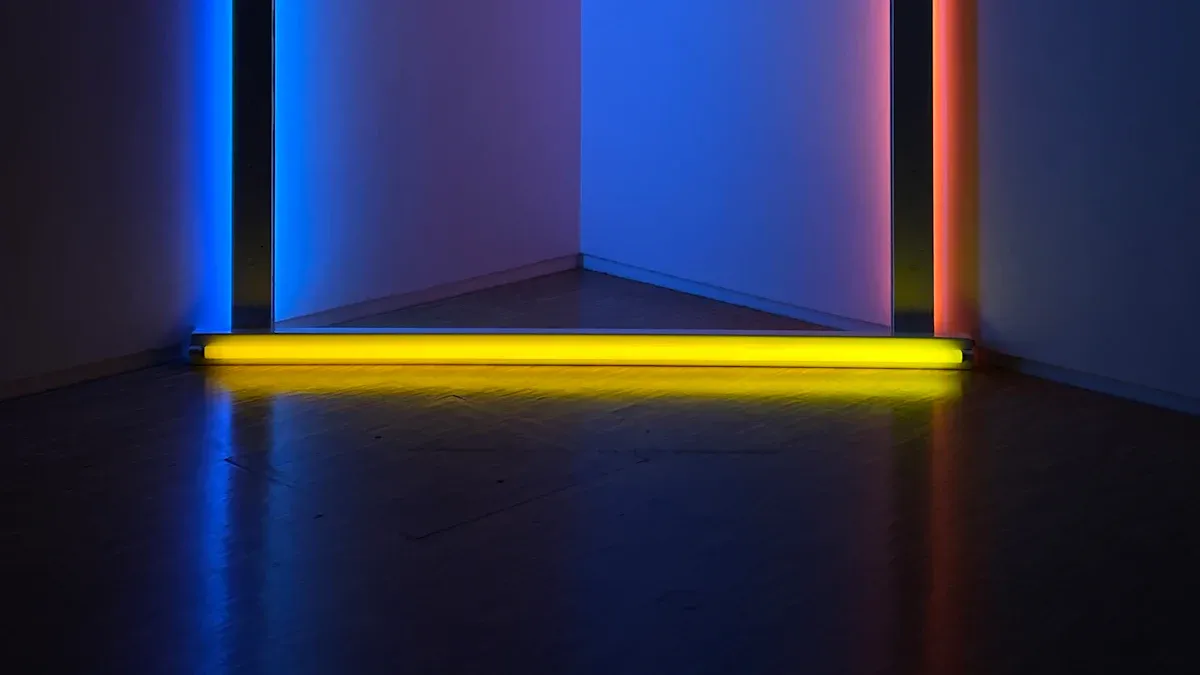
Before you start building your LED light box, you’ll need to gather the right materials and tools. Having everything ready will make the process smoother and more enjoyable. Let’s break it down step by step.
Essential materials for the frame
The frame is the backbone of your LED light box. You’ll want materials that are sturdy yet lightweight. Here’s what you’ll need:
Wood or aluminum strips: These will form the structure of your frame. Aluminum is great for a sleek, modern look, while wood is easier to work with if you’re a beginner.
Acrylic or polycarbonate sheet: This will act as the front cover, allowing light to pass through evenly.
Foam board or plywood: Use this for the back panel to provide support and stability.
Adhesive or screws: These will hold everything together. Choose adhesives for a seamless look or screws for extra durability.
Tip: If you’re unsure about the size, measure the artwork or poster you plan to display first. This will help you cut the materials to the right dimensions.
LED strip lights and power supply
The LED lights are the heart of your light box. They provide the illumination that makes your design pop. Here’s what to consider:
LED strip lights: Look for energy-efficient options with adjustable brightness. Some models even offer color-changing features for added customization.
Power supply: Choose one that matches the voltage and wattage of your LED strips. Here’s a quick comparison of popular models:
Model | Input Voltage | Output Voltage | Wattage | IP Rating | Dimming Function |
|---|---|---|---|---|---|
Mean Well APV | 90-264VAC | 5, 12, 15, 24, 36V | 8-35 Watts | IP42 | N/A |
Mean Well LPV | 90-264VAC | 5, 12, 15, 24, 36, 48VDC | 20-100 Watts | IP67 | N/A |
PWM Dimmable Supply | 90-305VAC | 12, 24, 36, 48VDC | 40-120 Watts | IP67 | 0-100% Dimming |
ODLV-45 | 90-295VAC | 12V to 60VDC | 45 Watts | IP67 | 0-10V and PWM |
Note: If you’re planning to use your light box outdoors, pick LED strips and power supplies with a high IP rating for water resistance.
Tools for cutting, assembling, and securing
You don’t need a workshop full of tools to build your LED light box. A few basic items will do the trick:
Measuring tape: Accuracy is key when cutting your materials.
Saw or cutter: Use a hand saw for wood or a hacksaw for aluminum. For acrylic sheets, a utility knife works well.
Drill and screwdriver: These are essential if you’re using screws to assemble the frame.
Hot glue gun or adhesive tape: Perfect for securing LED strips and other components.
Sandpaper: Smooth out rough edges for a polished finish.
Pro Tip: Always wear safety gear like gloves and goggles when cutting or drilling. It’s better to be safe than sorry!
With these materials and tools in hand, you’re all set to start building your LED light box. In the next section, we’ll dive into the step-by-step process of putting it all together.
Optional items for customization
After gathering the basics, think about adding personal touches. Customizing your LED light box can make it unique and fit your style. Here are some extra items to consider:
Colored LED strips: Want more fun? Use colored or RGB LEDs. These let you change the light’s color and mood easily.
Dimmer switch: Adjust the brightness with a dimmer. This is handy for different spaces, like a cozy bedroom or a bright workspace.
Remote control: Some LED kits include remotes. You can change brightness or colors without touching the box.
Diffuser film: For softer lighting, use a diffuser film. It spreads light evenly and reduces harsh spots.
Decorative trim or molding: Add a stylish border to your frame. Paint or stain it to match your room.
Tip: Think about where your light box will go. For a kid’s room, bright colors or fun designs work well. For a business, a simple, clean look might be better.
Creative Add-ons for a Unique Look
Feeling creative? Try these ideas to make your light box stand out:
Frosted acrylic sheets: Replace clear acrylic for a softer, modern glow.
Vinyl decals or stickers: Add designs, quotes, or logos to the frame or front.
Magnetic strips: Add magnets to the back. This makes switching posters or art easy.
Smart LED controllers: Control your light box with your phone. Change colors, brightness, or set schedules using an app.
Pro Tip: Keep your design useful. Fun extras are great, but don’t let them block the light box’s main job—showing off your art beautifully.
Practical Upgrades for Durability
If you’ll use your light box often or in busy areas, try these upgrades:
Protective coating: Spray a clear coat on the frame to stop scratches.
Weatherproofing materials: For outdoor use, seal edges with silicone. Pick waterproof LED strips and power supplies.
Reinforced corners: Add corner brackets or metal pieces to make the frame stronger.
Note: Customizing doesn’t have to cost much. Many of these items are cheap and easy to find at hardware or craft stores.
With these extras, your light box can be both useful and special. Whether you want a sleek, professional look or something fun and colorful, the options are endless. Be creative and enjoy the process!
Step-by-Step Guide to Building the LED Light Box Frame
Measuring and cutting the frame materials
Before you start cutting, grab your measuring tape and double-check the dimensions of your artwork or poster. This step ensures your light box frame fits perfectly. Once you have the measurements, mark them on your chosen material—whether it’s wood or aluminum strips. Accuracy here is key to avoid gaps or uneven edges later.
For a sturdy and professional look, consider using an L-shaped design for the frame. This shape not only makes the structure stronger but also helps you use your materials more efficiently. Plus, it adds depth to the frame, which prevents uneven lighting—a common issue in shallow designs.
Here’s how you can cut the materials:
Use a hand saw for wood or a hacksaw for aluminum.
For acrylic sheets, score the surface with a utility knife and snap it along the line.
Sand down any rough edges to avoid splinters or sharp corners.
Tip: Always wear safety goggles and gloves while cutting. Safety first!
Assembling the frame structure
Now that you’ve got your pieces ready, it’s time to assemble the frame. Lay out the cut materials on a flat surface to ensure everything aligns properly. Start by attaching the corners to form a rectangular or square shape, depending on your design.
Here’s a simple step-by-step process:
Use adhesive or screws to secure the corners. If you’re using screws, pre-drill holes to prevent the material from splitting.
Add support pieces made from MDF or scrap wood to hold the light panel in place. These pieces will also help stabilize the frame.
Reinforce the corners with brackets or extra adhesive for added durability.
If you’re aiming for a polished look, consider covering the exposed edges with foil tape. This not only hides imperfections but also reflects light, enhancing the brightness inside the box.
Pro Tip: Test the frame’s stability by gently pressing on each corner. If it wobbles, tighten the screws or add more adhesive.
Preparing the back panel and front cover
The back panel and front cover are essential for your LED light box. The back panel provides support, while the front cover ensures even light diffusion. Start by cutting a foam board or plywood for the back panel. Cover it with foil tape to reflect light and maximize brightness.
For the front cover, use an acrylic or polycarbonate sheet. If you want softer lighting, consider using frosted acrylic or adding a diffuser film. This helps spread the light evenly and eliminates harsh spots.
Here’s how to prepare these components:
Attach the back panel to the frame using screws or adhesive. Make sure it’s flush with the edges to avoid gaps.
Place the acrylic sheet on the front of the frame. Secure it with clips, screws, or a glass retainer frame.
Add foam boards between the back panel and the acrylic sheet to diffuse the light further.
Note: If you’re using a printout or artwork, test it with the LED lights before securing the front cover. This ensures the light distribution looks even and professional.
By following these steps, you’ll have a solid foundation for your LED light box. The next step is installing the LED lights, which will bring your design to life.
Securing the frame for stability
Your frame is built, but it needs to be strong. A sturdy frame keeps your light box safe and looking good. Follow these easy steps to make it stable.
1. Strengthen the corners
Corners are the weakest parts of the frame. If they’re loose, the frame can fall apart. To fix this:
Add corner brackets or L-brackets. These metal pieces give extra support.
Use strong glue like epoxy or wood glue before adding brackets. This makes the corners stronger.
Tighten screws gently. Too much force can crack wood or acrylic.
Tip: For aluminum frames, rivets work better than screws. They look cleaner and last longer.
2. Add support beams
Big frames need extra support to stay strong. Support beams stop the frame from bending.
Cut thin strips of wood, aluminum, or MDF. Place them across the back of the frame.
Attach them with screws or glue. Put them where the frame feels weak, like the middle or long edges.
This is important if you’ll hang the light box or use it in busy areas.
3. Secure the back panel
The back panel helps hold the frame together. Make sure it’s attached tightly.
Use screws or nails to fix the panel to the frame. Space them evenly around the edges.
If using glue, spread it along the edges. Press the panel firmly and let it dry.
Pro Tip: Check for gaps between the panel and frame. Gaps can weaken the frame and let light escape.
4. Test the stability
Before adding LED lights, test the frame’s strength. Stand it upright on a flat surface. Press gently on different parts. If it wobbles, tighten screws or add more glue.
Note: Don’t skip this step! A shaky frame can cause problems later, like when mounting it or changing the artwork.
By doing these steps, your light box frame will be strong and look great. A stable frame means your project will last, whether it’s for home, business, or a gift.
Installing LED Lights for Professional Illumination
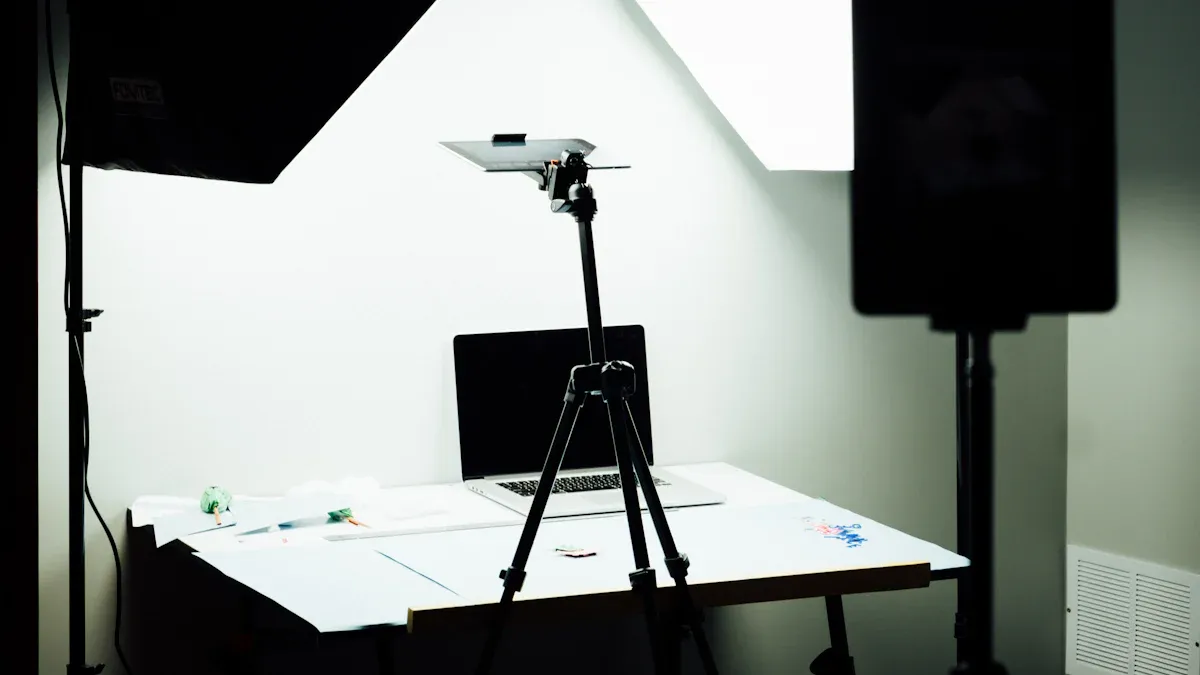
Picking the best LED strip lights
Choosing good LED strip lights is very important. They make your light box bright and look professional. Pick strips with at least 36 LEDs per foot. This spreads light evenly and avoids bright spots.
Check the brightness too. A good strip gives at least 450 lumens per foot. This is as bright as fluorescent lights. If you’re showing artwork or posters, pick strips with a high CRI (Color Rendering Index). A CRI over 80 shows colors clearly and makes designs look great.
Think about color temperature. For indoor use, 2700K (warm) to 6500K (cool) works well. Warm tones feel cozy, while cool tones suit modern or work spaces.
Tip: Don’t buy strips with low LED counts but high power claims. They wear out faster.
Sticking the LED strips to the frame
After picking your LED strips, attach them to the frame. Clean the surface first. Dust or grease can make the adhesive weak.
Peel off the strip’s backing and press it onto the frame. For even light, stick the strips along the inner edges. If the frame is big, add strips across the back panel too.
For extra hold, use adhesive clips or brackets. These help in humid or busy areas.
Pro Tip: Test where to place the strips before sticking them. This avoids uneven lighting.
Hooking up the power supply and testing
The last step is connecting the power supply. Make sure it matches your LED strip’s voltage, like 12V or 24V. It should also handle the strip’s total power needs.
Follow this checklist for easy setup:
Check if the power supply and LED strip connectors fit.
Use a multimeter to confirm the voltage is correct.
Secure connections with solder or quick-connect terminals.
Plug in the power supply and test the lights. Look for flickering or dim spots. If all looks good, your light box is ready to shine!
Note: If you’re unsure about wiring, ask an expert to stay safe.
Managing wires for a tidy look
Messy wires can make your LED light box look bad. But keeping them neat is easy with a few tricks. A clean setup also helps you fix or check your light box later.
First, organize the wires. Use cable clips to hold them along the back of the frame. These clips stick well and keep wires in place. If you have many wires, group them with cable sleeves. This reduces mess and makes your light box look better.
For bigger setups, try a cable tray under the frame. This tray holds wires safely and stops them from tangling. It’s great for wall-mounted light boxes or busy spaces.
Here’s a simple checklist to manage wires neatly:
Label your wires: Add small tags to know which wire is which.
Tidy extra wire: Wrap extra wire and secure it with zip ties.
Fix loose parts: Use clips or brackets to stop connectors from hanging.
John, a graphic designer, had messy wires in his office. He used cable clips and sleeves to organize them behind his desk. The result? A cleaner space that looked great and helped him work better.
Pro Tip: Test your LED lights after fixing the wires. This ensures everything works before securing them fully.
By following these tips, your light box will look neat and work well. A tidy finish makes a big difference!
Tips for Displaying Your Design in the LED Light Box
Selecting the right poster or artwork
Choosing the perfect design for your LED light box is key to making it stand out. Start by thinking about where you’ll display it. For a cozy living room, go with warm, inviting artwork. If it’s for a business, bold graphics or logos work better.
Make sure the size of your poster or artwork matches the dimensions of your light box. A snug fit avoids wrinkles or gaps that can ruin the look. If you’re displaying a diy movie poster, pick one with vibrant colors and sharp details. These pop beautifully under LED lighting.
For long-lasting results, print your design on high-quality paper or vinyl. These materials resist fading and hold up well over time.
Tip: Test your poster under the LED lights before securing it. This helps you spot any uneven lighting or color issues early.
Ensuring even light diffusion
Even light diffusion is what makes your design shine. Without it, you might see bright spots or shadows that distract from the artwork. Here are some simple ways to ensure uniform lighting:
Adjust LED brightness: Dimming the lights can improve diffusion and reduce harsh spots.
Use edge-mounted LEDs: Positioning the lights along the edges directs light sideways, creating a smoother glow.
Add mini-diffusers: Some LED strips come with tiny bubbles that scatter light evenly.
Space LEDs closer together: Tight spacing minimizes brightness variations and eliminates hot spots.
Check dispersion angle: Wider angles spread light better. Look for this feature when buying LED strips.
If you’re still seeing uneven lighting, try adding a diffuser film or frosted acrylic sheet to the front cover. These materials soften the light and make it look more professional.
Pro Tip: Test the light diffusion in a dark room. This makes it easier to spot and fix any issues.
Tips for mounting and replacing designs
Mounting your design securely is just as important as choosing the right artwork. A loose or crooked poster can ruin the overall look. Use clips, magnets, or adhesive strips to hold your design in place. Magnets are especially handy if you plan to switch posters often.
When replacing designs, take care not to damage the frame or LED lights. Remove the front cover gently and slide out the old artwork. If you’re using adhesive strips, peel them off slowly to avoid tearing the poster.
For a clean finish, wipe the acrylic sheet before adding a new design. Dust or smudges can affect how the light shines through.
Note: If you’re displaying seasonal designs, store unused posters flat in a dry place to keep them in good condition.
With these tips, your LED light box will always look polished and ready to impress. Whether it’s showcasing a diy movie poster or a custom artwork, the right setup makes all the difference.
Final Touches for a Polished LED Light Box
Painting or decorating the frame
Now that your light box is almost complete, it’s time to add some personality! Painting or decorating the frame can make it stand out or blend perfectly with your space. If you’re going for a modern look, try a sleek black or metallic finish. For a cozy vibe, warm wood tones or pastel colors work beautifully.
Before painting, sand the frame lightly to ensure the paint sticks well. Use a primer if you’re working with wood or aluminum. This helps the paint last longer and look smoother. Spray paint is a great option for an even coat, but a brush works fine for smaller areas.
Want to get creative? Add stencils, decals, or even a textured finish. If you’re displaying something like a diy movie poster, you could match the frame’s design to the theme of the artwork. For example, a vintage poster might look great with a distressed wood finish.
Tip: Use a clear protective coat after painting. It keeps the frame looking fresh and prevents scratches.
Checking for adjustments or improvements
Before you call it done, take a moment to check your light box for any tweaks it might need. Look for gaps in the frame or uneven edges. Tighten screws or add a bit of adhesive if anything feels loose.
Turn on the LED lights and inspect the brightness. Are there any dark spots or overly bright areas? If so, adjust the placement of the LED strips or add a diffuser film for better light distribution.
Also, check the wiring. Make sure everything is secure and hidden neatly. Loose wires not only look messy but can also cause issues later.
Pro Tip: Test your light box in a dark room. This helps you spot any lighting flaws that might not be visible in daylight.
Displaying your light box in the perfect spot
Where you place your light box can make all the difference. Choose a spot that complements the design and enhances the room’s ambiance. For example, indirect lighting works well in living rooms or bedrooms, creating a cozy atmosphere.
If you’re using the light box in a workspace or business, position it to reduce glare. Placing it at eye level or slightly above can improve visibility and comfort. Studies show that proper placement of light fixtures can reduce glare and improve visual comfort by directing light away from the eyes.
For outdoor use, consider light pollution. Avoid placing the light box near greenspaces or wildlife habitats, as excessive lighting can disrupt the environment.
Tip: Test the light box in different spots before settling on the final location. This ensures it looks great and functions well in its new home.
Making your own LED lightbox is both fun and useful. Picture your diy movie poster or artwork glowing in a frame you built. With simple materials and steps, you can create a high-quality lightbox without spending too much.
LED lightboxes aren’t just for decorating your home. They’re great for business displays, gifts, or making workspaces more engaging. Compared to regular displays, they grab more attention, tell better stories, and boost sales. Here’s a quick comparison:
Feature | LED Lightboxes | Regular Displays |
|---|---|---|
Attention Level | More engaging | Less engaging |
Storytelling Ability | Stronger stories | Limited stories |
Customer Insights | Tracks behavior | Little tracking |
Visitor Numbers | Increases foot traffic | Fewer visitors |
Sales Success | Higher sales | Lower sales |
Why wait? Start this project and show off your creativity. Whether for a cozy home spot or a bold business display, your lightbox will amaze everyone.
FAQ
What size should my LED light box be?
The size depends on your artwork or poster. Measure your design first, then add a small border for the frame. For example, if your poster is 18×24 inches, make the frame slightly larger to fit it snugly.
Tip: A larger frame works better for bold, eye-catching designs.
Can I use battery-powered LED strips?
Yes, you can! Battery-powered LED strips are great for portable or temporary displays. However, they may not last as long as plug-in options. Choose rechargeable batteries for convenience and to save money over time.
Note: Check the battery life to ensure it meets your needs.
How do I clean the acrylic front cover?
Use a soft, lint-free cloth and a mild cleaner. Avoid harsh chemicals or abrasive materials that could scratch the surface. Gently wipe in a circular motion to remove dust and smudges.
Pro Tip: Microfiber cloths work best for streak-free cleaning.
Can I use my light box outdoors?
Yes, but you’ll need weatherproof materials. Use waterproof LED strips, a high-IP-rated power supply, and seal the edges with silicone. This protects your light box from rain and humidity.
Emoji Reminder: 🌧️ Waterproofing is essential for outdoor use!
What’s the best way to mount my light box?
You can use wall hooks, screws, or adhesive strips. For heavier frames, opt for sturdy wall anchors. If you want flexibility, try a stand or easel for tabletop display.
Tip: Test the mounting method to ensure it holds securely.
See Also
Setting Up LED Light Bars For Signage Displays
Edge-Lit LED Bars For Illuminating Signage Solutions
Understanding The Functionality Of LED Light Bars In Lightboxes
Creating Your Own LED Neon Flex Sign From Scratch
Designing A Personalized Neon LED Sign For Your Space

